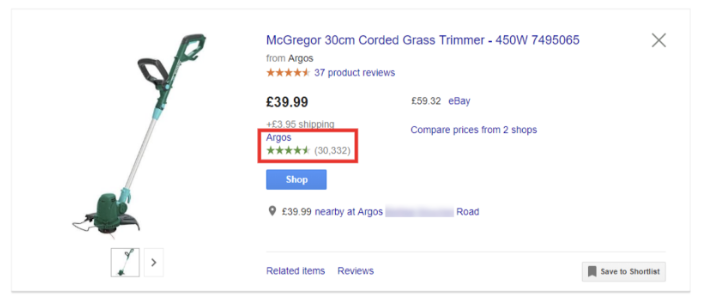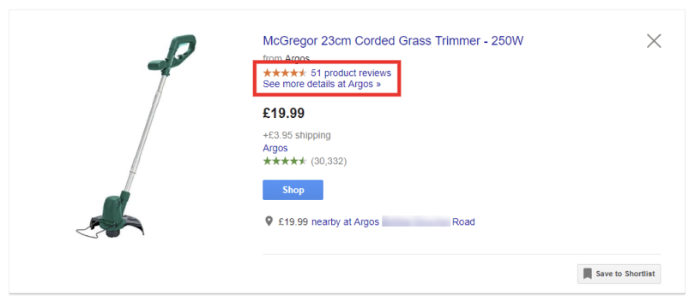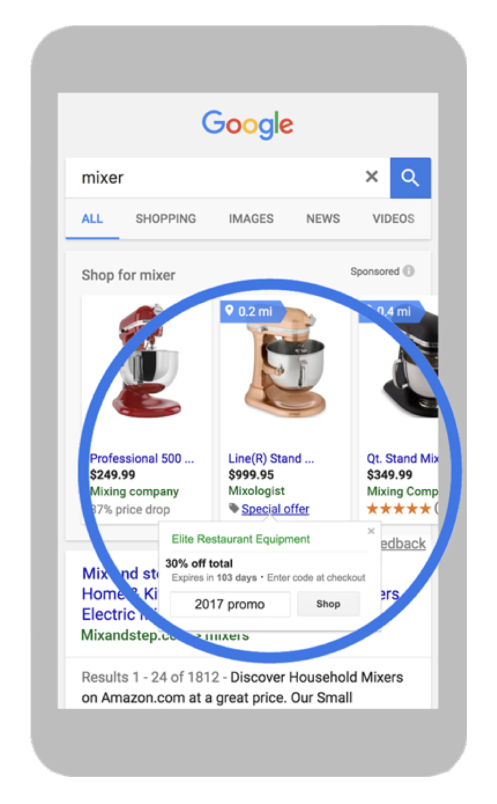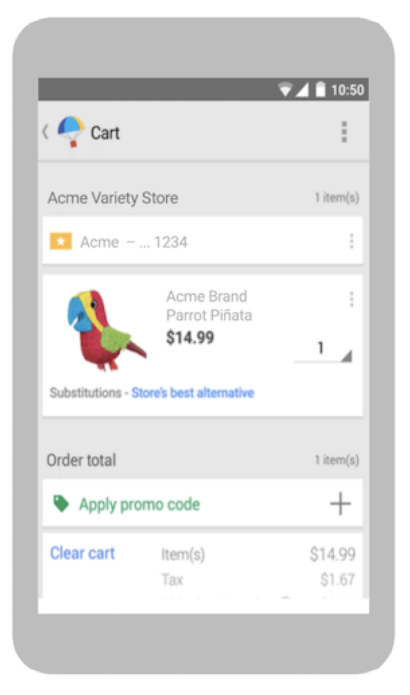
In order to run a successful store, every online merchant should be on Google Shopping trying to squeeze out as many sales as possible. But the question remains: "How can you optimize your Shopping Campaigns?". Assuming you’ve covered the basics, have your product data in a good shape and nailed your bidding strategies, where can you find more to do?
The answer is Google Shopping Programs.
Google Shopping Programs give you tools to help improve the conversions you get from your Google Shopping listings.
Below are six of the most important Google Shopping Programs, as well as advice for how to apply to or implement them.
Dynamic Remarketing on Google Shopping
Dynamic remarketing displays personalized Google Shopping ads to people who have visited your website recently. For example, you can set the ads to display products that a person previously viewed or products that are similar.
Requirements for Dynamic Remarketing Ads on Google Shopping
You can set up dynamic remarketing ads on Google Shopping in AdWords, so you must have an AdWords account and it must be linked to your Google Merchant Center account. Also, dynamic remarketing ads use a product data feed, so you must submit one through your Merchant Center account.
Advantages of Dynamic Remarketing Ads on Google Shopping
- Keeps your products, offers and website at the front of your customers’ minds
- Increases conversions
- Maximizes return on investment from your marketing efforts: i.e. you might not get the sale when the person initially visits your website, but you do get it in the end
Setting Up Dynamic Remarketing Ads on Google Shopping
-
Start by setting up a new dynamic remarketing campaign in Google AdWords. You do this after setting things like the location and budget of your campaign. Select Additional Settings > Dynamic Ads > Use a Data Feed for personalized ads. After this, set up an ad group using Remarketing Lists as the category.
-
Optimize and re-submit your product feed – see below.
-
Add Google's global site tag to your website so Google knows which products people visit. You must add this to every page on your website.
-
Create responsive ads to pull products from your data feed into the ads Google displays.
One of the ways you can optimize your data feed for dynamic remarketing ads is to change the way products appear in ads compared to how they appear in Google Shopping
One of the ways you can optimize your data feed for dynamic remarketing ads is to change the way products appear in ads compared to how they appear in Google Shopping. For example, you can change the title to appeal to people who have already shown interest in your product. Another example is changing the link to give you a better understanding of the source of visitors to your product pages.
To do this, you simply add extra fields to your product feed before submitting it to Google. DataFeedWatch helps you do this.
Here are some of the fields you can use:
- display_ads_id – give products a different ID
- display_ads_similar_id – recommend a similar product
- display_ads_title – give products different titles to those in Google Shopping
- display_ads_link – change the link
- display_ads_recommendation_preference – prioritise products to display in dynamic remarketing ads
2. Seller Ratings
Seller ratings are the stars you see on next to a merchant on Google Shopping. They are different from product ratings which apply to products: instead, seller ratings apply to the merchant.

Google uses a five-star system, and it gets data to determine your rating from a range of sources. This includes Google Customer Reviews, a free tool that lets you proactively gather reviews from customers.
Google has a list of trusted third-parties it uses to get data on the feedback customers give about your business.
Google also has a list of trusted third-parties it uses to get data on the feedback customers give about your business. This includes services like Yotpo, TrustPilot and Verified Reviews. These services help you get reviews from customers as well as give you tools to improve customer engagement and the customer experience.
Requirements for Seller Ratings
- 150 unique reviews in the past year
- Must be located in a country where Google has enabled Seller Ratings. This includes Australia, Canada, France, Germany, Ireland, New Zealand, Spain, the UK and the USA.
Advantages of Seller Ratings
- Builds customer trust
- Makes your business stand out on Google
- Adds social proof to your listings
How to Set Up Seller Ratings
How you set up Seller Ratings will depend on the review platform you use. Google Customer Reviews is one of the easiest, since you can do it directly from the Google Merchant Center.
When you're logged into Google Merchant Center, click on the Customer Reviews option on the navigation panel to the right of the page. Once you've done that you can add the survey opt-in module to your website to help you encourage customers to leave a review of your business.
3. Product Ratings
While Seller Ratings apply to your business overall, Product Ratings apply to your individual products. It's a five-star system that Google determines using real customer reviews of products.

### Requirements for Product Ratings
- Available in any country that has Google Shopping
- You must have 50 product reviews over all your products before Product Ratings will start to appear
- Individual products must have a least three product reviews before Product Ratings display
Ultimately, product ratings increase conversions.
Advantages of Product Ratings
Google Shopping Product ratings give customers confidence in your products. They are particularly powerful because they come from other customers, which generates social proof. Ultimately, product ratings increase conversions. They also make your products stand out on Google Shopping.
Setting Up Product Ratings
The first step to setting up product ratings is to start collecting ratings from customers. You can do this on your own website or you can use an approved third-party aggregator service. These services include Trustpilot, Yotpo and Verified Reviews.
The second step is to complete the Product Ratings Interest Form to sign up for Product Ratings. Once accepted, Google needs your reviews. If you use a third-party service, Google will retrieve the reviews from there. If you collect the reviews yourself, you'll need to ensure they are in the product feed you submit to Google Merchant Center.
4. Google Merchant Promotions
Google Merchant Promotions lets you add a promotion to a product listing on Google Shopping. This could be free delivery, a buy-one-get-one-free offer, a percentage discount or some other kind of deal.

### Requirements for Google Merchant Promotions
- You must be in Australia, France, Germany, India, the UK or the US.
- The promotion must be available to all customers. This means you can't, for example, have a promotion that is only available to first-time customers or another select group of people.
- The promotion must be a discount, a free gift, free delivery or discounted delivery.
Products that have a Google Merchant Promotion stand out on a search results page.
Advantages of Google Merchant Promotions
Products that have a Google Merchant Promotion stand out on a search results page. As a result, they can deliver a higher click-through rate and higher conversion rate.
Merchant Promotions can also help you upsell or cross-sell the customer. For example, you can offer a discount on product B when the customer purchases product A.
Setting Up Merchant Promotions
You must complete and submit an interest form before you can start using Merchant Promotions. Once Google approves your application, you will see a Promotions feed type in Google Merchant Center.
You can also use DataFeedWatch to prepare and submit your promotion feed to Google. This is as simple as creating the feed and adding the DataFeedWatch promotions feed URL to your Google Merchant Center account.
Your promotions feed must have an ID as well as other fields. You then simply add the promotion ID to applicable products in your main data feed.
5. Google Shopping Actions
Google Shopping Actions work more like an Amazon or eBay product listing than a traditional Google Shopping ad. In other words, the transaction takes place on a Google platform rather than the Shopping ad sending the customer to your website to process the transaction.
It is available to shoppers on Google Express, Google Assistant, some search results pages and elsewhere.

Requirements for Google Shopping Actions
- Google Shopping Actions is only available in the US at the moment.
- The products you sell must be in certain categories. These are household, health, beauty, baby, toddler, pet supplies, kitchen supplies, bathroom supplies, basic electronics, school supplies, office supplies, sporting goods, toys, apparel, hardware and grocery.
Advantages of Google Shopping Actions
- Displays your products on a wider range of Google platforms.
- Smooth user experience as customers can stay on Google to complete the transaction. This can increase conversion rates.
Setting Up Google Shopping Actions
You first need to complete an expression of interest in Google Shopping Actions. After you get approved, you must create the following:
- Local product feed – information about your products
- Local product inventory feed – information about your warehouse or store
You then must register and submit your feed to Google Merchant Center.
Local Inventory Ads target local shoppers with the objective of getting them into your shop.
6. Local Inventory Ads
Local Inventory Ads target local shoppers with the objective of getting them into your shop. So, when customers see Local Inventory Ads, they see information about the availability of the product in the shop closest to the customer, as well as the price of the product in that shop.
Requirements for Local Inventory Ads
- You must have a physical store that customers can visit
- You must be in one of the following countries: Australia, Brazil, Canada, France, Germany, Japan, the UK or the US
Advantages of Local Inventory Ads
- Increases footfall to your physical shop
- Appeals to the way customers want to buy
Setting Up Local Inventory Ads
After you enable local inventory ads, you need to create and then regularly update four different feeds:
- Google products feed – all the products you promote on Google Shopping
- Business information feed – information on each store location
- Google local products feed – information on the products available in-store
- Google local product inventory feed – stock and price information for each of your stores
You then need to request an inventory verification from Google. Once verified, go to your Google Shopping campaign and enable local.
Finally…
There is no perfect tip or trick to help you nail your Google Shopping Campaigns. At the end of the day is all about putting Google’s tools to your service.
What questions do you have about Shopping Programs? Ask them in the comments!











